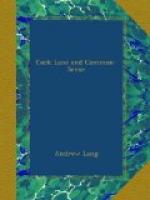The Abeille of Chartres held this letter over, till two of its reporters had visited the scene of action, and interviewed doctors, priests, and farmers, who all attested the facts. Happily, in this case, an exorcism by a priest proved efficacious. At Cideville, holy water and consecrated medals were laughed at by the sprite, who, by the way, answered to the name of Robert.
PRESBYTERIAN GHOST HUNTERS.
Religious excitement and hallucination. St. Anthony. Zulu catechumens. Haunted Covenanters. Strange case of Thomas Smeaton. Law’s ‘Memorialls’. A deceitful spirit. Examples of insane and morbidly sensitive ghosts. ‘Le revenant qui s’accuse s’excuse.’ Raising the devil in Irvine. Mode of evocation. Wodrow. His account of Margaret Lang, and Miss Shaw of Bargarran. The unlucky Shaws. Lord Torphichen’s son. Cases from Wodrow. Lord Middleton’s story. Haunted house. Wraiths. Lord Orrery’s ghost no metaphysician. The Bride of Lammermoor. Visions of the saints. Their cautiousness. Ghost appearing to a Jacobite. Ghost of a country tradesman. Case of telepathy known to Wodrow. Avenging spectres. Lack of evidence. Tale of Cotton Mather.
In spite of a very general opinion to the opposite effect, it is not really easy to determine in what kind of age, and in what conditions of thought and civilisation, ghosts will most frequently appear, and ghostly phenomena will chiefly abound. We are all ready to aver that ‘ghaists and eldritch fantasies’ will be most common ’in the dark ages,’ in periods of ignorance or superstition. But research in mediaeval chronicles, and in lives of the saints makes it apparent that, while marvels on a large and imposing scale were frequent, simple ordinary apparitions and haunted houses occur comparatively seldom. Perhaps they were too common to be thought worth noticing, yet they are noticed occasionally, and, even in these periods of superstition, were apparently regarded as not quite everyday phenomena.




